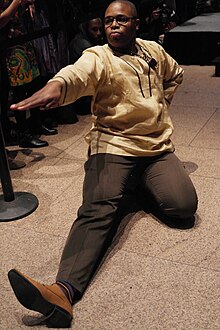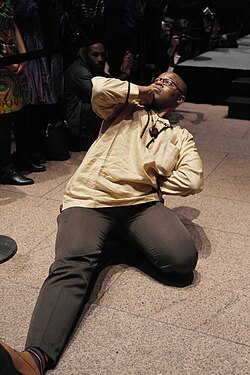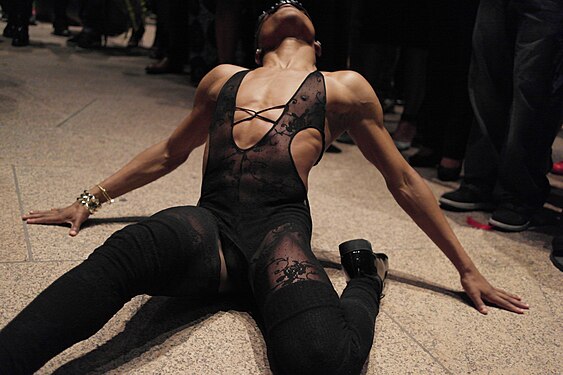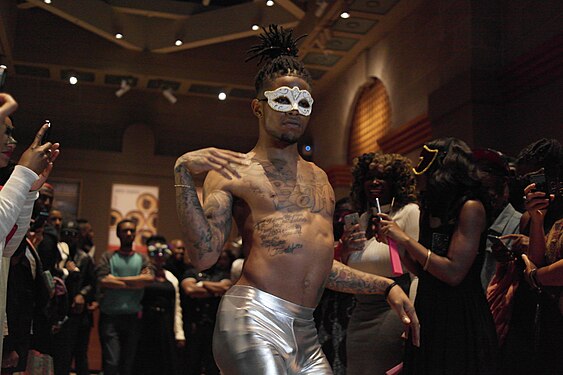Vogue (dance)
 performance at National Museum of African Art, 2016 | |
| Genre | House dance, Ball Culture |
|---|---|
| Inventor | Disputed |
| Year | 1980s–present |
| Origin | Harlem, New York City, United States |
Vogue, or voguing, is a highly stylized, modern house dance originating in the late 1980s that evolved out of the Harlem ballroom scene of the 1960s.[1] It gained mainstream exposure when it was featured in Madonna's song and video "Vogue" (1990), and when showcased in the 1990 documentary Paris Is Burning (which went on to win the Grand Jury Prize at the 1991 Sundance Film Festival).[2] In its modern form, this dance has become a global phenomenon that continues to evolve both stylistically and demographically.[3]
History
This style of dance arose from Harlem ballroom cultures, as danced by African-American and Latino gay/trans people, from the early 1960s through the 1980s. The Harlem Renaissance shaped a distinctly black LGBTQ culture in Harlem from 1920 to 1935, which included advancement in literature, arts and music and demonstration that aspects of identity like race, gender and sexuality can be fluid and intersecting. The drag competitions that began during this time eventually shifted from elaborate pageantry to vogue dance battles.[4] Inspired by the style of Ancient Egyptian Hieroglyphs and the famous images of models in Vogue magazine, voguing is characterized by striking a series of poses as if one is modeling for a photo shoot. Arm and leg movements are angular, linear, rigid, and move swiftly from one static position to another.[1]
Dance competitions often involved throwing "shade," or subtle insults directed at one another in order to impress the judges and the audience. The competition style was originally called "presentation" and later "performance."[5] Over the years, the dance evolved into the more intricate and acrobatic form that is now called "vogue".[2][3][6]
Vogue dance presents gender as a performance. Drag queens pretend to apply makeup ("beat face"), style hair and don extravagant clothing through the dance moves.[7] Depending on the competition category, participants may perform the traditional behaviors of their assigned sex to demonstrate "realness," or passing as straight.[8] Although there are varying gender and sexuality classifications and categories, each fits into either Female Figure (FF) or Male Figure (MF). Female Figure includes trans women, cisgender women and drag queens, while Male Figure includes butch queens, butch women and cisgender men.[9] No matter the category, performances and competitions are camp (style), which embodies the spirit of extravagance and is exaggerated and artificial.[10][11]
The precise origins of voguing are disputed. Although many cite the story in which Paris Dupree takes out a Vogue magazine and mimics the poses to the beat of the music (and other queens subsequently followed), there are other accounts that note voguing may have originated from black gay prison inmates at Rikers Island, performed for the attention of other men as well as throwing shade.[1] Voguing is continually being developed further as an established dance form that is practiced in the Black and Latino gay ballroom scene, and clubs in major cities throughout the United States and around the globe — mainly New York City and Paris.[3][12]
Styles
There are currently three distinct styles of vogue: Old Way (pre-1990); New Way (post-1990); and Vogue Fem (circa 1995).[13]
Old way
Old way is characterized by the formation of lines, symmetry, and precision in the execution of formations with graceful, fluid-like action. Egyptian hieroglyphs and fashion poses serve as the original inspirations for old way voguing. In its purest, historical form, old way vogue is a duel between two rivals. Traditionally, old way rules dictated that one rival must "pin" the other to win the contest. Pinning involved the trapping of an opponent so that they could not execute any movements while the adversary was still in motion (usually voguing movements with the arms and hands called "hand performance" while the opponent was "pinned" against the floor doing "floor exercises" or against a wall).[14]
New way
New way is characterized by rigid movements coupled with "clicks" (limb contortions at the joints) and "arms control" (hand and wrist illusions, which sometimes includes tutting and locking). New way can also be described as a modified form of mime in which imaginary geometric shapes, such as a box, are introduced during motion and moved progressively around the dancer's body to display the dancer's dexterity and memory. New way involves incredible flexibility.[2]
Vogue Fem
Vogue Fem ("Fem" is derived from the French word femme, meaning "woman") is fluidity at its most extreme with exaggerated feminine movements influenced by ballet, jazz and modern dance. Styles of Vogue Fem performances range from Dramatics (which emphasizes stunts, tricks, and speed) to Soft (which emphasizes a graceful, beautiful, and easy flow continuations between the five elements). There are currently five elements of Vogue Fem:
- Duckwalk: The duck walk receives its name from the appearance the name references (a duck walking) that involves squatting on your heels and kicking your feet out as you move forward on the beat.
- Catwalk: Catwalking is an exaggerated feminine walk where the legs are crossed over each other, the hips are thrust from side to side, and the hands are thrown forward in opposition to the legs.
- Hands: In performance, the hands of the performer often told a story. This is the component of performing used to throw shade. For example, miming an expression of horror at the way the opponents face looks.
- Floorwork: This component demonstrates the competitors' sensuality as they roll, twist, and otherwise move on the ground in such a way as to capture the attention of the judges.
- Spins and Dips: This is the showiest component of vogue. These are the turns on beat, and the drops to the floor. A spin or dip is only done correctly when executed with the climax happening on the beat.[15]
-
A participant at the National Museum of African Art's 2016 Voguing Masquerade Ball
Scenes and chapters
The ballroom scene has evolved into a national and international underground dancesport with major balls and dance competitions being held in different regions of the United States and around the world.[16] New York State continues to be the mecca of the ballroom scene as well as the dance style, but regional voguing "capitals" exist—Chicago and Detroit for the Midwest. Atlanta, Charlotte, Dallas, Miami for the South. Los Angeles and Las Vegas for the West Coast. Baltimore, D.C, Connecticut, Philadelphia, Pittsburgh. and Virginia for the East Coast.[17]
International cities in Western Europe (the U.K., France, the Netherlands, Germany, Austria and Sweden), Eastern Europe, Latin America (Mexico, Brazil, Chile, Colombia, Costa Rica, Panama) and Asia Pacific (Japan and New Zealand) have sprouted and held competitions inspired by voguing from the original balls of New York City.[18][19][20][21]
Influences

Several notable pop celebrities and artists were influenced by Voguing. Madonna, Teyana Taylor, Rihanna, Willow Smith, FKA Twigs, Ariana Grande, and Azealia Banks have all taken inspiration from voguing from dances of past and contemporary voguers, while also incorporating the beats traditionally attached to the dance.[22][23][24][25]
One of the most recent influences of voguing (and Ball culture) comes from the documentary film Kiki, in which contemporary Balls and Voguing is represented through the scenes and styles that now exist.[26][27]
When the dance culture of New York travelled to Berlin, many people went to clubs to show off their best moves. At a time when discrimination was very severe especially for those exploring their identities, these clubs offered people a space to avoid those struggles. People focused on their dance and outdoing their peers and competitors rather than society's rejection of minority groups. The House of Melody was the first German voguing house. It brought together people passionate for voguing. They emphasized ignoring people's backgrounds and instead understanding everyone's shared belief in love for all.[28] These clubs were important for people who might have been looking for a place to escape the challenges that they faced on the streets or at home. The empowerment that was generated in these spaces transferred into contributing to a broader movement that would tend to the struggles of minorities in Germany.
Although Madonna's song 'Vogue' brought popularity and awareness to the dance style, the pop singer still received criticism from those who believe she exploited and appropriated the ballroom culture.[29] Cultural appropriation involves the adoption of certain aspects of a minority or disadvantaged culture by a member of the majority culture without proper acknowledgement of the origin.[30] The 1990 music video was choreographed by Jose Gutierez Xtravaganza and Luis Camacho of the House of Xtravaganza. However, all of the celebrities mentioned in the song are white, and Madonna herself is a white woman. Even though Madonna referenced the Harlem ballroom culture by including members of the community in the production of the video, critics still say that she erased the originating culture since she is the primary mainstream association with the style.[31]
See also
- "Deep in Vogue"
- House of Aviance
- House of Xtravaganza
- How Do I Look
- LGBT culture in New York City
- Pose (TV series)
- Strike a Pose
- Willi Ninja
- Legendary (TV series)
References
- ^ a b c Stuart., Baker (2011-01-01). Voguing and the house ballroom scene of New York City 1989-92. ISBN 9780955481765. OCLC 863223074.
- ^ a b c Becquer, Marcos; Gatti, Jose (1991-09-01). "Elements of Vogue". Third Text. 5 (16–17): 65–81. doi:10.1080/09528829108576327. ISSN 0952-8822.
- ^ a b c Schaefer, Brian (2015-07-23). "Vogueing Is Still Burning Up the Dance Floor in New York". The New York Times. ISSN 0362-4331. Retrieved 2017-05-01.
- ^ "A Brief History of Voguing". The National Museum of African American History & Culture. Smithsonian Institution. Retrieved 13 December 2019.
- ^ Jackson, Jonathan David (Autumn 2002). "The Social World of Voguing" (PDF). Journal for the Anthropological Study of Human Movement. 12 (2): 26–42.
- ^ Upadhye, Janet (2012-06-21). "Vogue: Not Madonna's Dance". HuffPost. Retrieved 2017-05-02.
- ^ "A Brief History of Voguing". The National Museum of African American History & Culture. Smithsonian Institution. Retrieved 13 December 2019.
- ^ Buckner, Rachel. "Underground Ball Culture". Grinnell College. Retrieved 13 December 2019.
- ^ Wallace, Stephaun Elite. "Ball Categories". House of Luna. Retrieved 13 December 2019.
- ^ Jeffs, Lotte (2016-10-04). "What is Voguing?". Elle. Retrieved 13 December 2019.
- ^ Bekhrad, Joobin. "What does it mean to be camp?". BBC. Retrieved 13 December 2019.
- ^ Veine, France (March 13, 2014). "French Drag Queen Dance Battles". VICE. Retrieved April 1, 2017.
- ^ Tara, Susman (2000-01-01). "The Vogue of Life: Fashion Culture, Identity, and the Dance of Survival in the Gay BalIs". DisClosure: A Journal of Social Theory. 9 (1). doi:10.13023/disclosure.09.15. ISSN 1055-6133.
- ^ Livingston, Jennie (1991-08-01), Paris Is Burning, retrieved 2017-05-02
- ^ Oxygen Media (2016-06-02), The 5 Elements of Vogue with Leiomy Maldonado - In Progress | Oxygen, retrieved 2017-05-02
- ^ streetstar (2013-08-22), STREETSTAR 2013 - Vogue Femme Final Battle Lasseindra (FRA) vs Ida"Inxi" Holmlund (FIN), retrieved 2017-03-20
- ^ Bailey, Marlon M. (2013-08-29). Butch queens up in pumps : gender, performance, and ballroom culture in Detroit. ISBN 9780472051960. OCLC 820123691.
- ^ "Inside Eastern Europe's Wild, Competitive Voguing Scene". Vice. Retrieved 2017-05-02.
- ^ "Watch: Aya-Bambi, the Japanese dancing couple who will leave you hypnotised". CatchNews.com. Retrieved 2017-05-02.
- ^ Morton, Frances (May 9, 2017). "Inside New Zealand's Radical Pacific Queer Community". Vice. New Zealand. Retrieved Sep 13, 2017.
- ^ Villegas, Richard (2016). "How voguing and ballroom became cool in Latin America". Remezcla. Retrieved May 30, 2018.
- ^ Hunt, Kenya (2014-11-18). "How voguing came back into vogue". The Guardian. ISSN 0261-3077. Retrieved 2017-05-02.
- ^ "Meet Leiomy Maldonado, the Trans Latina Vogue Dancer Whose Hair Flip Inspired Beyoncé & More". LATINA. Retrieved 2017-05-02.
- ^ "NEW MUSIC: Azealia Banks' new Vogue-worthy track "The Big Big Beat" is an instant-hit". afropunk.com. Retrieved 2017-05-02.
- ^ "Leiomy Maldonado Talks Signature Hair Flip That Inspired Beyoncé". Vibe. 2017-01-25. Retrieved 2017-05-02.
- ^ Kenny, Glenn (2017-02-28). "Review: 'Kiki': The Vogueing Scene, Still a Refuge for Gay and Transgender Youth". The New York Times. ISSN 0362-4331. Retrieved 2017-05-02.
- ^ MovieZine (2016-06-30), Kiki (2016) - Trailer, retrieved 2017-05-02
- ^ "the house of melody - HOME". thehouseofmelody.com (in German). Retrieved 2018-03-24.
- ^ Chatzipapatheodoridis, Constantine (2017). "Strike a Pose, Forever: The Legacy of Vogue and its Re-contextualization in Contemporary Camp Performances". European Journal of American Studies. 11 (3). doi:10.4000/ejas.11771.
- ^ "cultural appropriation". Cambridge Dictionary.
- ^ Goodman, Elyssa. "The Historic, Mainstream Appropriation of Ballroom Culture". Them. Retrieved 13 December 2019.
External links
 Media related to Vogue (dance) at Wikimedia Commons
Media related to Vogue (dance) at Wikimedia Commons




